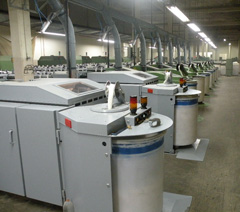
Selection
This process is carried out by a team of expert buyers working at different warehouses in several productive centres across the country, which guarantees that the quality and uniformity of the products offered meet the highest international standards to provide our customers with the finest and most durable special fibres.
Sorting
While most companies have left this process behind to keep costs down, we stick to sortingas a major step and the first one into the production process, which is key in obtaining high-quality end products.
Every single fibre is picked through by the skilled hands of people who have turned this task into a craft and who help break up the fleece to come up with the different products we offer. Once fibres are sorted through and broken up into sections of different quality, they are ready to undergo the transformation process. The quality of the fibres will depend on the different parts of the animal’s body from which the fleece is shorn, including the back, the sides, the buttocks, and the eyes, as well as on the length and fineness of the fleece.
Scouring
Scouring involves putting the fibre through a scouring machine to remove as much dirt and grease (lanoline) as possible. Thus, the first step in the transformation of fleece is completed, with fibre looking a whole lot different. During scouring, chemical agents are first introduced in the process.
Before scouring in itself begins, however, the fleece goes through a willowing and opening machine which, as its name suggests, beats and opens out the fibres to rid them of most “nips” (dirt and dust) and to allow them to be then washed in a series of baths, making it possible for detergent to better penetrate into and deeply clean the fleece. The dust resulting from this process is aspired by a set of filters and later disposed of in landfills or for soil fertilisation purposes.
Once the fleece is opened out, it goes into the scouring line through a conveyor. This line is equipped with several water tubs of approximately 5,000 litres each. Squeeze rollers come next in the process, which is brought to an end when the fleece is put into a dryer fed by gas-powered generators. Bowls are divided into two types: scouring bowls —containing detergentand sodium bicarbonate—, and rinsing bowls. Water temperature varies between 35º and 55º degrees Celsius and a steam boiler is used for this purpose.
Once the wool has passed through the tubs and the dryer, it is deemed to be scoured and is transferred to cooling boxes through air-injection tubes.
Combing
Several machines perform different functions throughout the carding process. They are all installed in a single facility, and fibres must go through each of the machines to be considered combed wool.
However, before being put through the combing process, different oils and solutions are added to the fleece, such as antistatic agents and softeners, a process which is called fibre “lubrication” and is accomplished by sprinkling the aqueous solution on the fibres by means of a sprayer.
Packing
Packing or baling is made by means of a pneumatic press which compresses bales ranging between 350 and 500 kilograms, depending on the type of fibre. Materials used in pressing bales include baling wire, and plastic or burlap. Once a bale is made, it is stored for subsequent dispatch.
Speciality Fibres Dehairing (including Guanaco and Vicuña fibres)
Besides processing ordinary wool and hair, our company engages in the processing of special, fine Vicuña and Guanaco fibres. These speciality fibres go through a transformation process similar to that of common fibres, but for the following differences:
Once sorted and scoured, fleece is subjected to dehairing, rather than carding. The dehairing process helps set fine fibres with commercial value apart from coarse fibres (guard hairs), which have no value at all. This process is performed with the aid of a dehairing machine which resembles a carding machine.
Once dehaired, the fine fibres are baled for export, with fibre being put on sale as “DEHAIRED Guanaco or Vicuña Fibre”. Alternatively, speciality fibres may be combed and put through the same process carried out with all other fibres.
The commercial value of these special fibres may be up to 100 times as high as the value of regular sheep wool.
The steps involved in the combing process are as follows:
Carding: The carding machine or card is the one which turns scoured wool into a continuous strand of fibres called a “top” (or a “sliver”). The carding machine removes most vegetable matter and dust.
(Preparer) Gilling: Fibres go through gilling on machines called gill boxes, which lay the fibres parallel and prepare them for combing. For improved combing, fibres undergo 3 gillings, with each gill box having ever thinner toothed pins.
Combing: This step is performed by combs which further straighten the fibres and remove small pieces of vegetable matter, as well as short fibres known as the “first and the second noil,” which are regarded as waste material. Noils have a low commercial value and are generally sold for felt hat making and for the manufacturing of stuffing material, among other uses.
Finisher Gilling: This phase is also carried out with gill boxes like those used in the earlier preparation gilling stage. The aim at this point is to finally and evenly blend the fibre strand drawn out from the combs given that, based on customer requirements, the top delivered must be in the range of 35 to 25 grams per metre.
Winding: Once the fibres in a top are fully parallel to each other and free of impurities, and the top weighs as many grams as required, bumps (also known as bobbins) of about 10 kilograms are formed with a gill box having a built-in bobbin.
The bumps are then wrapped in polyethylene bags and taken to the press to be made into wool bales.






